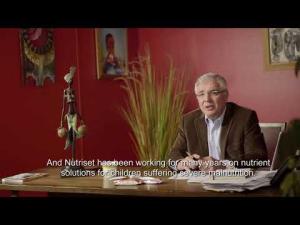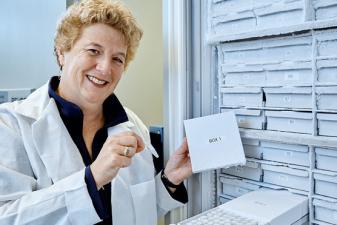Michel Lescanne
Nutritional paste that combats malnutrition
Finalist for the European Inventor Award 2015
Plumpy’Nut is a supplementary source of protein, vitamins and calories in a peanut paste form, developed to help children suffering from Severe Acute Malnutrition. If these children are facing no other health complications, they can gain weight and stabilize without having to spend time in a hospital.
Because doctor supervision is not necessary for its distribution, Plumpy’Nut offers a noticeable advantage over its predecessors in the therapeutic food field. Unlike so many powdered foodstuffs which must be mixed with water before use, the paste is ready to eat straight from the sachet, thereby avoiding any diseases in the local water supply.
Societal benefit
Statistics on global hunger and malnutrition are alarming. Approximately 800 million people worldwide do not have access to sufficient food sources, with around 200 million of these being children suffering severe or chronic malnutrition. The World Health Organisation estimates that malnutrition is linked to roughly 45% of deaths of children under the age of five. In 2013, this amounted to nearly 3 million children whose lives might have been saved if they had access to enough food. And this number could have been much higher if not for the widespread distribution of the Ready-to-Use Therapeutic Food (RUTF) Plumpy’Nut.
In 2007, the World Health Organisation, UNICEF, the United Nations Standing Committee on Nutrition, and the World Food Programme issued a statement approving the use of RUTF to treat malnutrition. Plumpy’Nut is currently purchased and distributed by UNICEF and other humanitarian groups in hunger-stricken areas. An seven-week treatment, often enough to take a child from starving to stable, costs approximately €30 per child.
Plumpy’Nut’s success stories include helping quell a food crisis in Niger in 2005. Using the product, Médecins Sans Frontières treated more than 60,000 children. Within a few months, 90% of the children recovered completely.
Economic benefit
Plumpy’Nut has become a key means of RUTF, making up 60% of UNICEF’s supply in 2014, in a market that was valued at around € 163 million (US$ 200 million). Today, procurement volumes by UNICEF are four times higher than in 2009, and Nutriset is prepared to further expand their production as orders come in from other humanitarian groups as well.
As of 2014, Nutriset had 160 employees and revenues of around € 110 million. Since 2005, the company has been working to establish production of Plumpy’Nut where the product is used locally. Their reports show that in 2014, over 11,000 metric tons of the paste were made in developing countries, out of a total of 46,000 metric tons produced that year. Furthermore, the main Nutriset factory in Malaunay, France, has extra production lines in case of a severe food crisis.
How it works
Plumpy’Nut’s recipe calls for between 10-20% of skimmed milk and 10-20% of whey and meets the criteria for not having more than 50% of its proteins come from milk or dairy products. Mixing the ingredients in just the right proportions is vital to maximise nutritional value and stability in storage. The paste does not requiring mixing with the local water, which is often a health-risk in itself, and it requires no cooking either.
The food supplement was the first of its kind – paste not powder – to offer a long shelf life and no additional preparation steps or hospital supervision when used. Since 2005, over 25 million people have received Plumpy’Nut or Nutriset’s nutrient fortifier for infants Enov’.
The inventor
Did you know?
Media gallery
Patent numbers:
Contact
European Inventor Award and Young Inventors Prize queries:
european-inventor@epo.org Subscribe to the European Inventor Award newsletterMedia-related queries:
Contact our Press team#InventorAward #YoungInventors





